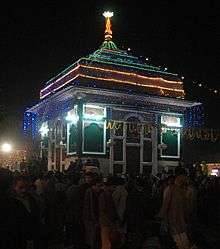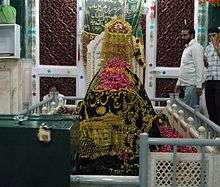Mian Mir

Baba Sain Mir Mohammed Sahib (c. 1550 – 22 August 1635), popularly known as Mian Mir or Miyan Mir, was a famous Sufi Muslim saint who resided in Lahore, specifically in the town of Dharampura (in present-day Pakistan). He was a direct descendant of Caliph Umar ibn al-Khattab. He belonged to the Qadiri order of Sufism. He is famous for being a spiritual instructor of Dara Shikoh, the eldest son of Mughal emperor Shah Jahan.[1][2] He is identified as the founder of the Mian Khail branch of the Qadiri order. His younger sister Bibi Jamal Khatun was a disciple of his and a notable Sufi saint in her own right.[3][4]
Mian Mir and Emperor Jahangir

Mian Mir was a friend of God-loving people and he would shun worldly, selfish men, covetous Emirs and ambitious Nawabs who ran after faqirs to get their blessings. To stop such people from coming to see him, Mian Mir posted his mureeds (disciples) at the gate of his house.
Once, Jahangir, the Mughal emperor, with all his retinue came to pay homage to the great faqir. He came with all the pomp and show that befitted an emperor. Mian Mir's sentinels however, stopped the emperor at the gate and requested him to wait until their master had given permission to enter. Jahangir felt slighted. No one had ever dared delay or question his entry to any place in his kingdom. Yet he controlled his temper and composed himself. He waited for permission. After a while, he was ushered into Mian Mir's presence. Unable to hide his wounded vanity, Jahangir, as soon as he entered, told Mian Mir in Persian: Ba dar-e-darvis darbane naa-bayd ("On the doorstep of a faqir, there should be no sentry").
Pir Mian Mir, whose mind and soul were one with the Lord, caring little for the emperor's irritation, replied in Persian: Babayd keh sag-e-dunia na ayad ("They are there so that the dogs of the world/selfish men may not enter").
The emperor was embarrassed and asked for forgiveness. Then, with folded hands, Jahangir requested Mian Mir to pray for the success of the campaign which he intended to launch for the conquest of the Deccan. Meanwhile, a poor man entered and, bowing his head to Mian Mir, made an offering of a rupee before him. The Sufi asked the devotee to pick up the rupee and give it to the poorest, neediest person in the audience. The devotee went from one dervish to another but none accepted the rupee. The devotee returned to Mian Mir with the rupee saying: "Master, none of the dervishes will accept the rupee. None is in need, it seems."
"Go and give this rupee to him," said the faqir, pointing to Jahangir. "He is the poorest and most needy of the lot. Not content with a big kingdom, he covets the kingdom of the Deccan. For that, he has come all the way from Delhi to beg. His hunger is like a fire that burns all the more furiously with more wood. It has made him needy, greedy and grim. Go and give the rupee to him."
Mian Mir, the Sikh Gurus and his place in Sikhism
Mian Mir, holds a pivotal legendary place in Sikhism and in Sikh history. Sikh people around the world learn about him, his spiritual contribution and his place in Sikh history.
Mian Mir and Guru Arjan meet
Guru Arjan Dev, the fifth Sikh Guru, often visited Lahore, the birthplace of his father (the fourth Guru, Guru Ram Das) to meet his relatives. On the occasion of one of such visits, he called on Mian Mir and they met.. Mian Mir was thirteen years older than Guru Arjan.
The foundation-stone of the Harmandir Sahib
Guru Arjan was responsible for the construction of many tanks and buildings. In 1588, he planned to build a temple in the centre of the holy tank called Amritsar or the pool of the nectar of immortality. As the temple was to be thrown open to people of all religions, castes, creeds and climes, he invited Mian Mir to lay the foundation stone of the Harmandir Sahib. He came to the city of Amritsar wearing a religious mendicant's long cloak made up of patches of coarse wool and a cone-shaped cap, with a rose flower on top. Mian Mir was given one of the warm welcomes for which Guru Arjan was famous. The two holy men embraced each other in sincere love and regard. The purpose of the temple was disclosed to the Sufi saint. Mian Mir was delighted at the fine objectives the Guru had in mind. The foundation-stone was laid in January 1588.[5]
Guru Arjan's death
In 1606, Guru Arjan was implicated in the affair of Prince Khusraw, who had rebelled against his father, Jahangir. He was imprisoned in the Lahore fort and tortured. When Mian Mir heard about it, he came to see the Guru. He found Guru Arjan calm and serene, having completely resigned himself to the will of God. Mian Mir suggested to the Guru whether he should intercede with Emperor Jahangir on his behalf. The Guru forbade him saying that God's will must have its course unchecked, as it was not proper to interfere with its working.
Guru Har Gobind
A couple of years after the death of Guru Arjan, his son and successor Guru Har Gobind, who was thirteen years of age was called on Mian Mir at Lahore.
Guru Tegh Bahadur
Guru Tegh Bahadur, the son of Guru Har Gobind and the ninth Guru, as a child met Mian Mir who blessed him.
Death

After having lived a long life of piety and virtuosity, Hazrat Mian Mir died on 22 August 1635 (7 Rabi' al-awwal, 1045 according to the Islamic Calendar). He was eighty-eight years old.
His funeral oration was read by Mughal prince Dara Shikoh, who was a highly devoted disciple of the Saint.
Tomb
He was buried at a place which was about a mile from Lahore near Alamganj, that is at the south-east of the city. Hazrat Mian Mir's spiritual successor was Hazrat Mullah Shah Badakhshi. Hazrat Mian Mir's Mazar (Mausoleum) still attracts hundreds of devotees each day and he is revered by many Sikhs as well as Muslims. The tomb's architecture still remains quite intact to this day.
References
- ↑ Hanif, N. (2000). Biographical Encyclopaedia of Sufis: South Asia. Sarup & Sons, New Delhi. ISBN 8176250872. pp. 205–209.
- ↑ Larson, Gerald J.; Jacobsen, Knut A. (2005). Theory and practice of yoga: essays in honour of Gerald James Larson (Print). Leiden Boston: Brill Publishers. pp. 307, 315. ISBN 9789004147577.
- ↑ Rizvi, Saiyid Athar Abbas (1983). A History of Sufism in India. 2. New Delhi: Munshiram Manoharlal. p. 481. ISBN 81-215-0038-9.
- ↑ Ernst, Carl W. (1997). The Shambhala Guide to Sufism. Boston: Shambhala. p. 67. ISBN 9781570621802.
- ↑ "Saint Hazrat Mian Mir". SikhWiki.
External links
| Wikimedia Commons has media related to Mian Mir. |
- Mian Mir on Chishti.ru
- About Mian Mir's shrine
- Mian Mir on AllAboutSikhs.com
- Article on Mian Mir published in the Times of India
